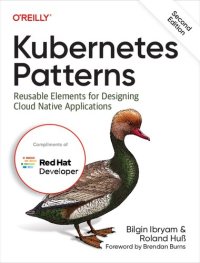
Ebook: Kubernetes Patterns: Reusable Elements for Designing Cloud Native Applications (2nd Ed)
Author: Bilgin Ibryam Roland Huß
- Genre: Computers // Databases
- Year: 2023
- Publisher: O’Reilly Media
- Edition: 2
- Language: English
- pdf
What’s New in the Second Edition
The Kubernetes ecosystem has continued to grow since the first edition came out four years ago. As a result, there have been many Kubernetes releases, and more tools and patterns for using Kubernetes have become de facto standards.
Fortunately, most of the patterns described in our book have stood the test of time and remain valid. Therefore, we have updated these patterns, added new features up to Kubernetes 1.26, and removed obsolete and deprecated parts. For the most part, only minor changes were necessary, except for Chapter 29, “Elastic Scale”, and Chapter 30, “Image Builder”, which underwent significant changes due to new developments in these areas.
Additionally, we have included five new patterns and introduced a new category, Part V, “Security Patterns”, which addresses a gap in the first edition and provides important security-related patterns for developers.
Our GitHub examples have been updated and extended. And, lastly, we added 50% more content for our readers to enjoy.
Kubernetes Patterns
The way developers design, build, and run software has changed significantly with the evolution of microservices and containers. These modern architectures offer new distributed primitives that require a different set of practices than many developers, tech leads, and architects are accustomed to. With this focused guide, Bilgin Ibryam and Roland Huß provide common reusable patterns and principles for designing and implementing cloud native applications on Kubernetes.
Each pattern includes a description of the problem and a Kubernetes-specific solution. All patterns are backed by and demonstrated with concrete code examples. This updated edition is ideal for developers and architects who are familiar with basic Kubernetes concepts but want to learn how to solve common cloud native challenges with proven design patterns.
The Kubernetes ecosystem has continued to grow since the first edition came out four years ago. As a result, there have been many Kubernetes releases, and more tools and patterns for using Kubernetes have become de facto standards.
Fortunately, most of the patterns described in our book have stood the test of time and remain valid. Therefore, we have updated these patterns, added new features up to Kubernetes 1.26, and removed obsolete and deprecated parts. For the most part, only minor changes were necessary, except for Chapter 29, “Elastic Scale”, and Chapter 30, “Image Builder”, which underwent significant changes due to new developments in these areas.
Additionally, we have included five new patterns and introduced a new category, Part V, “Security Patterns”, which addresses a gap in the first edition and provides important security-related patterns for developers.
Our GitHub examples have been updated and extended. And, lastly, we added 50% more content for our readers to enjoy.
Kubernetes Patterns
The way developers design, build, and run software has changed significantly with the evolution of microservices and containers. These modern architectures offer new distributed primitives that require a different set of practices than many developers, tech leads, and architects are accustomed to. With this focused guide, Bilgin Ibryam and Roland Huß provide common reusable patterns and principles for designing and implementing cloud native applications on Kubernetes.
Each pattern includes a description of the problem and a Kubernetes-specific solution. All patterns are backed by and demonstrated with concrete code examples. This updated edition is ideal for developers and architects who are familiar with basic Kubernetes concepts but want to learn how to solve common cloud native challenges with proven design patterns.
Download the book Kubernetes Patterns: Reusable Elements for Designing Cloud Native Applications (2nd Ed) for free or read online
Continue reading on any device:

Last viewed books
Related books
{related-news}
Comments (0)